Organisational Behaviour: Job Satisfaction & Commitment Report
VerifiedAdded on 2020/09/08
|10
|2494
|131
Report
AI Summary
This report provides a comprehensive literature review on organisational behaviour, focusing on the impact of employee attitudes, job satisfaction, and organisational commitment. It examines how attitudes are determined, the benefits of positive attitudes for individuals, and the factors that influence job satisfaction and commitment. The report highlights the importance of managers understanding and caring for their staff's perspectives, emphasizing the role of organisational commitment in fostering a positive work environment. It explores the relationship between employee attitudes and behaviour, discussing various research findings and studies that analyze the interplay of emotions, stress, and cognitive behaviours in the workplace. The report stresses the importance of management strategies and employee engagement for fostering employee loyalty and trust. The report also examines the crucial link between organisational commitment, job satisfaction, and overall firm productivity, suggesting that a positive work environment and effective management practices are essential for long-term success.

Organisational
Behaviour
Behaviour
Paraphrase This Document
Need a fresh take? Get an instant paraphrase of this document with our AI Paraphraser

Table of Contents
LITERATURE REVIEW................................................................................................................3
Determining employees attitudes at his workplace.....................................................................3
Benefits of attitudes for an individual.........................................................................................4
Factors that determine job satisfaction or organisational commitment......................................5
Managers under organisation must care about their staff perspective. ......................................6
REFERENCES................................................................................................................................8
LITERATURE REVIEW................................................................................................................3
Determining employees attitudes at his workplace.....................................................................3
Benefits of attitudes for an individual.........................................................................................4
Factors that determine job satisfaction or organisational commitment......................................5
Managers under organisation must care about their staff perspective. ......................................6
REFERENCES................................................................................................................................8
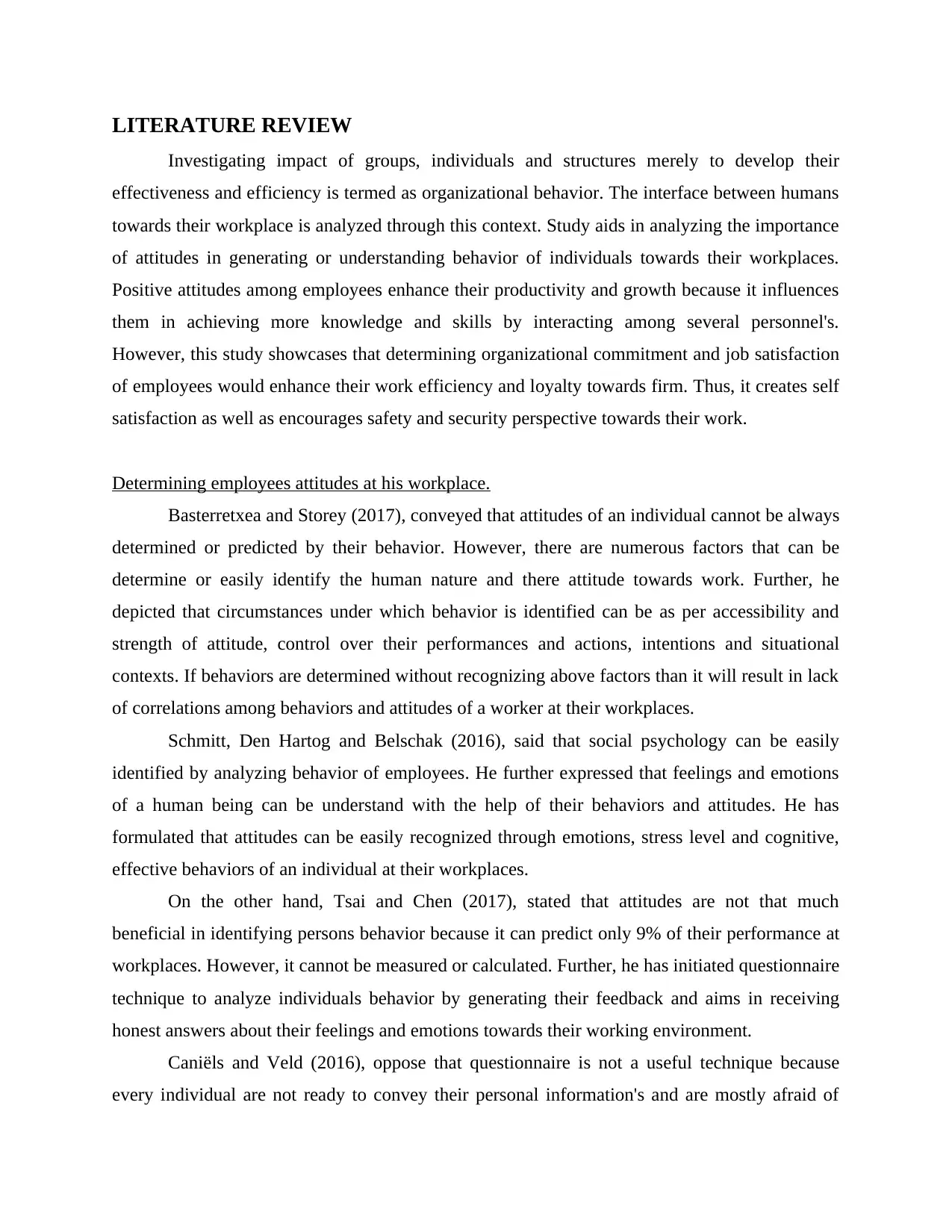
LITERATURE REVIEW
Investigating impact of groups, individuals and structures merely to develop their
effectiveness and efficiency is termed as organizational behavior. The interface between humans
towards their workplace is analyzed through this context. Study aids in analyzing the importance
of attitudes in generating or understanding behavior of individuals towards their workplaces.
Positive attitudes among employees enhance their productivity and growth because it influences
them in achieving more knowledge and skills by interacting among several personnel's.
However, this study showcases that determining organizational commitment and job satisfaction
of employees would enhance their work efficiency and loyalty towards firm. Thus, it creates self
satisfaction as well as encourages safety and security perspective towards their work.
Determining employees attitudes at his workplace.
Basterretxea and Storey (2017), conveyed that attitudes of an individual cannot be always
determined or predicted by their behavior. However, there are numerous factors that can be
determine or easily identify the human nature and there attitude towards work. Further, he
depicted that circumstances under which behavior is identified can be as per accessibility and
strength of attitude, control over their performances and actions, intentions and situational
contexts. If behaviors are determined without recognizing above factors than it will result in lack
of correlations among behaviors and attitudes of a worker at their workplaces.
Schmitt, Den Hartog and Belschak (2016), said that social psychology can be easily
identified by analyzing behavior of employees. He further expressed that feelings and emotions
of a human being can be understand with the help of their behaviors and attitudes. He has
formulated that attitudes can be easily recognized through emotions, stress level and cognitive,
effective behaviors of an individual at their workplaces.
On the other hand, Tsai and Chen (2017), stated that attitudes are not that much
beneficial in identifying persons behavior because it can predict only 9% of their performance at
workplaces. However, it cannot be measured or calculated. Further, he has initiated questionnaire
technique to analyze individuals behavior by generating their feedback and aims in receiving
honest answers about their feelings and emotions towards their working environment.
Caniëls and Veld (2016), oppose that questionnaire is not a useful technique because
every individual are not ready to convey their personal information's and are mostly afraid of
Investigating impact of groups, individuals and structures merely to develop their
effectiveness and efficiency is termed as organizational behavior. The interface between humans
towards their workplace is analyzed through this context. Study aids in analyzing the importance
of attitudes in generating or understanding behavior of individuals towards their workplaces.
Positive attitudes among employees enhance their productivity and growth because it influences
them in achieving more knowledge and skills by interacting among several personnel's.
However, this study showcases that determining organizational commitment and job satisfaction
of employees would enhance their work efficiency and loyalty towards firm. Thus, it creates self
satisfaction as well as encourages safety and security perspective towards their work.
Determining employees attitudes at his workplace.
Basterretxea and Storey (2017), conveyed that attitudes of an individual cannot be always
determined or predicted by their behavior. However, there are numerous factors that can be
determine or easily identify the human nature and there attitude towards work. Further, he
depicted that circumstances under which behavior is identified can be as per accessibility and
strength of attitude, control over their performances and actions, intentions and situational
contexts. If behaviors are determined without recognizing above factors than it will result in lack
of correlations among behaviors and attitudes of a worker at their workplaces.
Schmitt, Den Hartog and Belschak (2016), said that social psychology can be easily
identified by analyzing behavior of employees. He further expressed that feelings and emotions
of a human being can be understand with the help of their behaviors and attitudes. He has
formulated that attitudes can be easily recognized through emotions, stress level and cognitive,
effective behaviors of an individual at their workplaces.
On the other hand, Tsai and Chen (2017), stated that attitudes are not that much
beneficial in identifying persons behavior because it can predict only 9% of their performance at
workplaces. However, it cannot be measured or calculated. Further, he has initiated questionnaire
technique to analyze individuals behavior by generating their feedback and aims in receiving
honest answers about their feelings and emotions towards their working environment.
Caniëls and Veld (2016), oppose that questionnaire is not a useful technique because
every individual are not ready to convey their personal information's and are mostly afraid of
⊘ This is a preview!⊘
Do you want full access?
Subscribe today to unlock all pages.

Trusted by 1+ million students worldwide
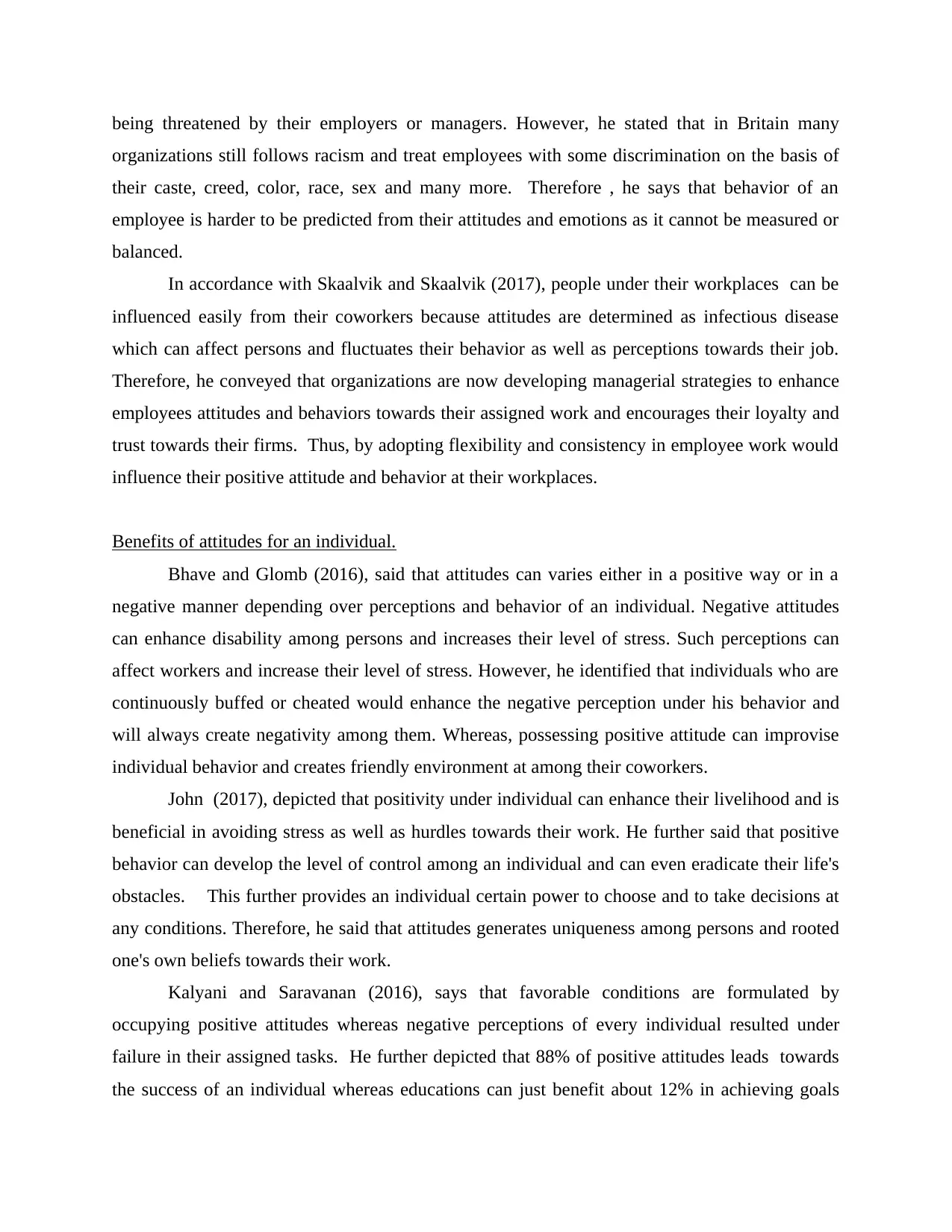
being threatened by their employers or managers. However, he stated that in Britain many
organizations still follows racism and treat employees with some discrimination on the basis of
their caste, creed, color, race, sex and many more. Therefore , he says that behavior of an
employee is harder to be predicted from their attitudes and emotions as it cannot be measured or
balanced.
In accordance with Skaalvik and Skaalvik (2017), people under their workplaces can be
influenced easily from their coworkers because attitudes are determined as infectious disease
which can affect persons and fluctuates their behavior as well as perceptions towards their job.
Therefore, he conveyed that organizations are now developing managerial strategies to enhance
employees attitudes and behaviors towards their assigned work and encourages their loyalty and
trust towards their firms. Thus, by adopting flexibility and consistency in employee work would
influence their positive attitude and behavior at their workplaces.
Benefits of attitudes for an individual.
Bhave and Glomb (2016), said that attitudes can varies either in a positive way or in a
negative manner depending over perceptions and behavior of an individual. Negative attitudes
can enhance disability among persons and increases their level of stress. Such perceptions can
affect workers and increase their level of stress. However, he identified that individuals who are
continuously buffed or cheated would enhance the negative perception under his behavior and
will always create negativity among them. Whereas, possessing positive attitude can improvise
individual behavior and creates friendly environment at among their coworkers.
John (2017), depicted that positivity under individual can enhance their livelihood and is
beneficial in avoiding stress as well as hurdles towards their work. He further said that positive
behavior can develop the level of control among an individual and can even eradicate their life's
obstacles. This further provides an individual certain power to choose and to take decisions at
any conditions. Therefore, he said that attitudes generates uniqueness among persons and rooted
one's own beliefs towards their work.
Kalyani and Saravanan (2016), says that favorable conditions are formulated by
occupying positive attitudes whereas negative perceptions of every individual resulted under
failure in their assigned tasks. He further depicted that 88% of positive attitudes leads towards
the success of an individual whereas educations can just benefit about 12% in achieving goals
organizations still follows racism and treat employees with some discrimination on the basis of
their caste, creed, color, race, sex and many more. Therefore , he says that behavior of an
employee is harder to be predicted from their attitudes and emotions as it cannot be measured or
balanced.
In accordance with Skaalvik and Skaalvik (2017), people under their workplaces can be
influenced easily from their coworkers because attitudes are determined as infectious disease
which can affect persons and fluctuates their behavior as well as perceptions towards their job.
Therefore, he conveyed that organizations are now developing managerial strategies to enhance
employees attitudes and behaviors towards their assigned work and encourages their loyalty and
trust towards their firms. Thus, by adopting flexibility and consistency in employee work would
influence their positive attitude and behavior at their workplaces.
Benefits of attitudes for an individual.
Bhave and Glomb (2016), said that attitudes can varies either in a positive way or in a
negative manner depending over perceptions and behavior of an individual. Negative attitudes
can enhance disability among persons and increases their level of stress. Such perceptions can
affect workers and increase their level of stress. However, he identified that individuals who are
continuously buffed or cheated would enhance the negative perception under his behavior and
will always create negativity among them. Whereas, possessing positive attitude can improvise
individual behavior and creates friendly environment at among their coworkers.
John (2017), depicted that positivity under individual can enhance their livelihood and is
beneficial in avoiding stress as well as hurdles towards their work. He further said that positive
behavior can develop the level of control among an individual and can even eradicate their life's
obstacles. This further provides an individual certain power to choose and to take decisions at
any conditions. Therefore, he said that attitudes generates uniqueness among persons and rooted
one's own beliefs towards their work.
Kalyani and Saravanan (2016), says that favorable conditions are formulated by
occupying positive attitudes whereas negative perceptions of every individual resulted under
failure in their assigned tasks. He further depicted that 88% of positive attitudes leads towards
the success of an individual whereas educations can just benefit about 12% in achieving goals
Paraphrase This Document
Need a fresh take? Get an instant paraphrase of this document with our AI Paraphraser
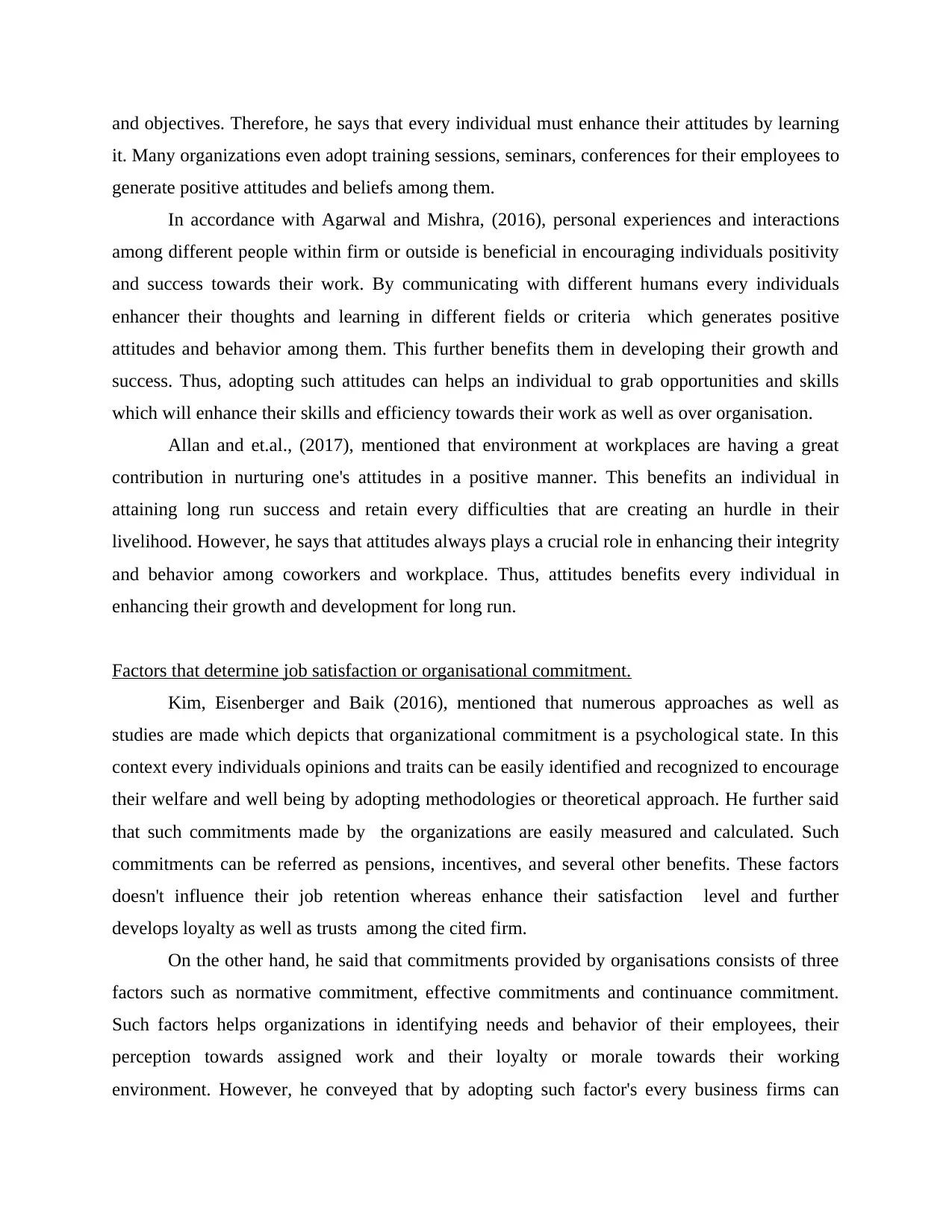
and objectives. Therefore, he says that every individual must enhance their attitudes by learning
it. Many organizations even adopt training sessions, seminars, conferences for their employees to
generate positive attitudes and beliefs among them.
In accordance with Agarwal and Mishra, (2016), personal experiences and interactions
among different people within firm or outside is beneficial in encouraging individuals positivity
and success towards their work. By communicating with different humans every individuals
enhancer their thoughts and learning in different fields or criteria which generates positive
attitudes and behavior among them. This further benefits them in developing their growth and
success. Thus, adopting such attitudes can helps an individual to grab opportunities and skills
which will enhance their skills and efficiency towards their work as well as over organisation.
Allan and et.al., (2017), mentioned that environment at workplaces are having a great
contribution in nurturing one's attitudes in a positive manner. This benefits an individual in
attaining long run success and retain every difficulties that are creating an hurdle in their
livelihood. However, he says that attitudes always plays a crucial role in enhancing their integrity
and behavior among coworkers and workplace. Thus, attitudes benefits every individual in
enhancing their growth and development for long run.
Factors that determine job satisfaction or organisational commitment.
Kim, Eisenberger and Baik (2016), mentioned that numerous approaches as well as
studies are made which depicts that organizational commitment is a psychological state. In this
context every individuals opinions and traits can be easily identified and recognized to encourage
their welfare and well being by adopting methodologies or theoretical approach. He further said
that such commitments made by the organizations are easily measured and calculated. Such
commitments can be referred as pensions, incentives, and several other benefits. These factors
doesn't influence their job retention whereas enhance their satisfaction level and further
develops loyalty as well as trusts among the cited firm.
On the other hand, he said that commitments provided by organisations consists of three
factors such as normative commitment, effective commitments and continuance commitment.
Such factors helps organizations in identifying needs and behavior of their employees, their
perception towards assigned work and their loyalty or morale towards their working
environment. However, he conveyed that by adopting such factor's every business firms can
it. Many organizations even adopt training sessions, seminars, conferences for their employees to
generate positive attitudes and beliefs among them.
In accordance with Agarwal and Mishra, (2016), personal experiences and interactions
among different people within firm or outside is beneficial in encouraging individuals positivity
and success towards their work. By communicating with different humans every individuals
enhancer their thoughts and learning in different fields or criteria which generates positive
attitudes and behavior among them. This further benefits them in developing their growth and
success. Thus, adopting such attitudes can helps an individual to grab opportunities and skills
which will enhance their skills and efficiency towards their work as well as over organisation.
Allan and et.al., (2017), mentioned that environment at workplaces are having a great
contribution in nurturing one's attitudes in a positive manner. This benefits an individual in
attaining long run success and retain every difficulties that are creating an hurdle in their
livelihood. However, he says that attitudes always plays a crucial role in enhancing their integrity
and behavior among coworkers and workplace. Thus, attitudes benefits every individual in
enhancing their growth and development for long run.
Factors that determine job satisfaction or organisational commitment.
Kim, Eisenberger and Baik (2016), mentioned that numerous approaches as well as
studies are made which depicts that organizational commitment is a psychological state. In this
context every individuals opinions and traits can be easily identified and recognized to encourage
their welfare and well being by adopting methodologies or theoretical approach. He further said
that such commitments made by the organizations are easily measured and calculated. Such
commitments can be referred as pensions, incentives, and several other benefits. These factors
doesn't influence their job retention whereas enhance their satisfaction level and further
develops loyalty as well as trusts among the cited firm.
On the other hand, he said that commitments provided by organisations consists of three
factors such as normative commitment, effective commitments and continuance commitment.
Such factors helps organizations in identifying needs and behavior of their employees, their
perception towards assigned work and their loyalty or morale towards their working
environment. However, he conveyed that by adopting such factor's every business firms can
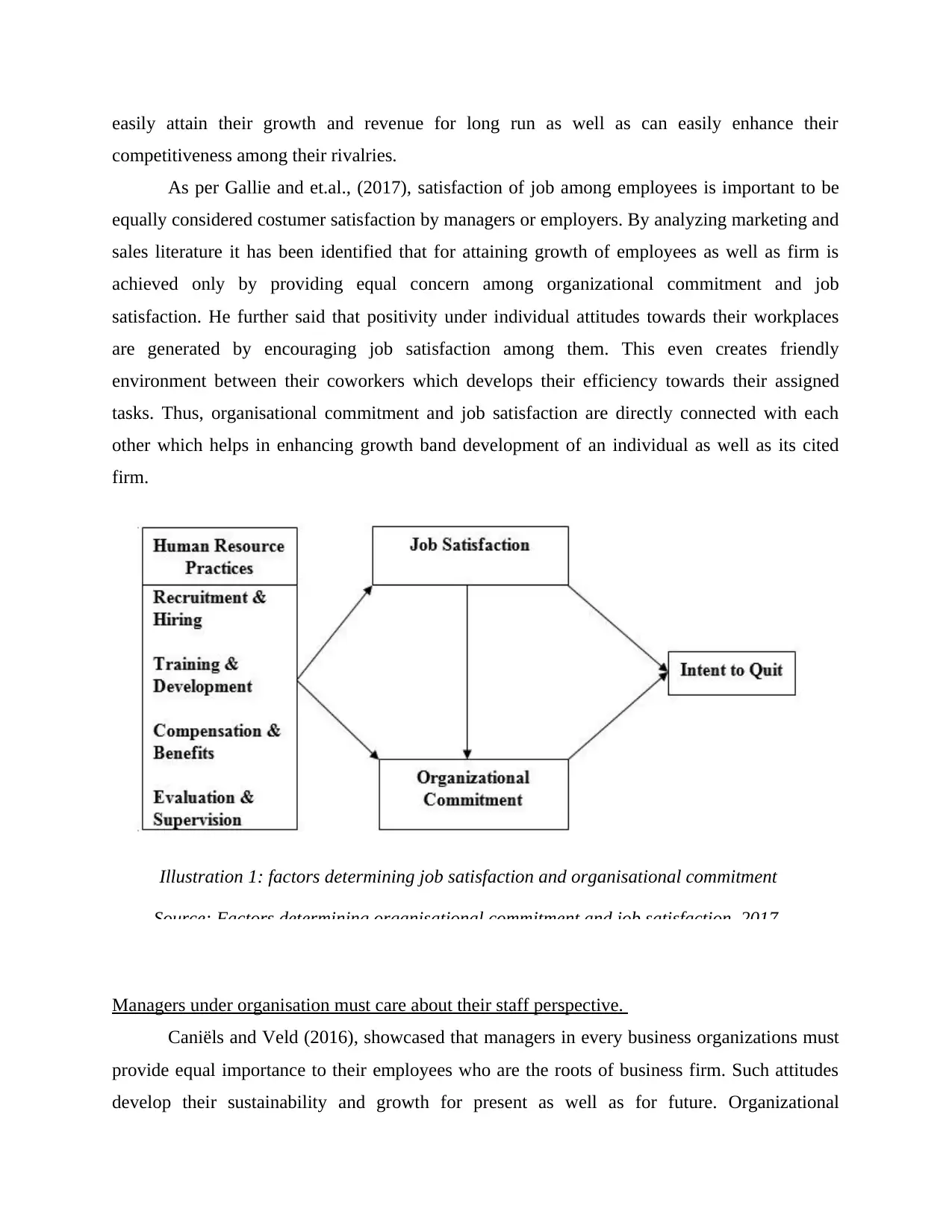
easily attain their growth and revenue for long run as well as can easily enhance their
competitiveness among their rivalries.
As per Gallie and et.al., (2017), satisfaction of job among employees is important to be
equally considered costumer satisfaction by managers or employers. By analyzing marketing and
sales literature it has been identified that for attaining growth of employees as well as firm is
achieved only by providing equal concern among organizational commitment and job
satisfaction. He further said that positivity under individual attitudes towards their workplaces
are generated by encouraging job satisfaction among them. This even creates friendly
environment between their coworkers which develops their efficiency towards their assigned
tasks. Thus, organisational commitment and job satisfaction are directly connected with each
other which helps in enhancing growth band development of an individual as well as its cited
firm.
Managers under organisation must care about their staff perspective.
Caniëls and Veld (2016), showcased that managers in every business organizations must
provide equal importance to their employees who are the roots of business firm. Such attitudes
develop their sustainability and growth for present as well as for future. Organizational
Illustration 1: factors determining job satisfaction and organisational commitment
Source: Factors determining organisational commitment and job satisfaction. 2017.
competitiveness among their rivalries.
As per Gallie and et.al., (2017), satisfaction of job among employees is important to be
equally considered costumer satisfaction by managers or employers. By analyzing marketing and
sales literature it has been identified that for attaining growth of employees as well as firm is
achieved only by providing equal concern among organizational commitment and job
satisfaction. He further said that positivity under individual attitudes towards their workplaces
are generated by encouraging job satisfaction among them. This even creates friendly
environment between their coworkers which develops their efficiency towards their assigned
tasks. Thus, organisational commitment and job satisfaction are directly connected with each
other which helps in enhancing growth band development of an individual as well as its cited
firm.
Managers under organisation must care about their staff perspective.
Caniëls and Veld (2016), showcased that managers in every business organizations must
provide equal importance to their employees who are the roots of business firm. Such attitudes
develop their sustainability and growth for present as well as for future. Organizational
Illustration 1: factors determining job satisfaction and organisational commitment
Source: Factors determining organisational commitment and job satisfaction. 2017.
⊘ This is a preview!⊘
Do you want full access?
Subscribe today to unlock all pages.

Trusted by 1+ million students worldwide

commitment is beneficial to be adopted because it influences managers in organizing training
sessions or seminars for employees which creates motivation and reduces their turnover and
absenteeism. He says that organizational commitment is increasingly valuable which assures
employees that at what extent their managers are concerned about them.
Skaalvik and Skaalvik (2017), mentioned that by providing incentives, retirement
benefits, compensations etc. employees attitudes and behaviors towards their workplaces are
changed and evaluated in a positive manner. However, he says that such care and positive
response reduces retention of employees and enhance its productivity and expansion for long
run. Such organizational commitments raise a momentum of 'job for life' within every workers
which creates positivity and loyalty between workers and employers/managers.
He further said that organizational commitment has become centralized factor which is
now focused majorly under human resource management to generate care and safety for their
subordinates. Further, he conveyed that adoption of such factors encourages strength among
employees and their weaknesses can be easily identified and overcome to achieve their planned
goals and objectives. Thus, organizational commitment plays a vital role in enhancing managers
behavior and care towards their employees.
The above study depicts that organizational commitment and job satisfaction are rthe
most crucial factors that brings change and set dimensions in order to enhance firm productivity
and growth for long term. This further encourages job security and safety as well as creates
friendly relations between coworkers which encourages employees to provide commitment
towards their work and organization. Managers showcase concerns over employees by initiating
organizational commitment techniques which achieves morale of workers which result in
generating positivity in their assigned work and behavior.
sessions or seminars for employees which creates motivation and reduces their turnover and
absenteeism. He says that organizational commitment is increasingly valuable which assures
employees that at what extent their managers are concerned about them.
Skaalvik and Skaalvik (2017), mentioned that by providing incentives, retirement
benefits, compensations etc. employees attitudes and behaviors towards their workplaces are
changed and evaluated in a positive manner. However, he says that such care and positive
response reduces retention of employees and enhance its productivity and expansion for long
run. Such organizational commitments raise a momentum of 'job for life' within every workers
which creates positivity and loyalty between workers and employers/managers.
He further said that organizational commitment has become centralized factor which is
now focused majorly under human resource management to generate care and safety for their
subordinates. Further, he conveyed that adoption of such factors encourages strength among
employees and their weaknesses can be easily identified and overcome to achieve their planned
goals and objectives. Thus, organizational commitment plays a vital role in enhancing managers
behavior and care towards their employees.
The above study depicts that organizational commitment and job satisfaction are rthe
most crucial factors that brings change and set dimensions in order to enhance firm productivity
and growth for long term. This further encourages job security and safety as well as creates
friendly relations between coworkers which encourages employees to provide commitment
towards their work and organization. Managers showcase concerns over employees by initiating
organizational commitment techniques which achieves morale of workers which result in
generating positivity in their assigned work and behavior.
Paraphrase This Document
Need a fresh take? Get an instant paraphrase of this document with our AI Paraphraser
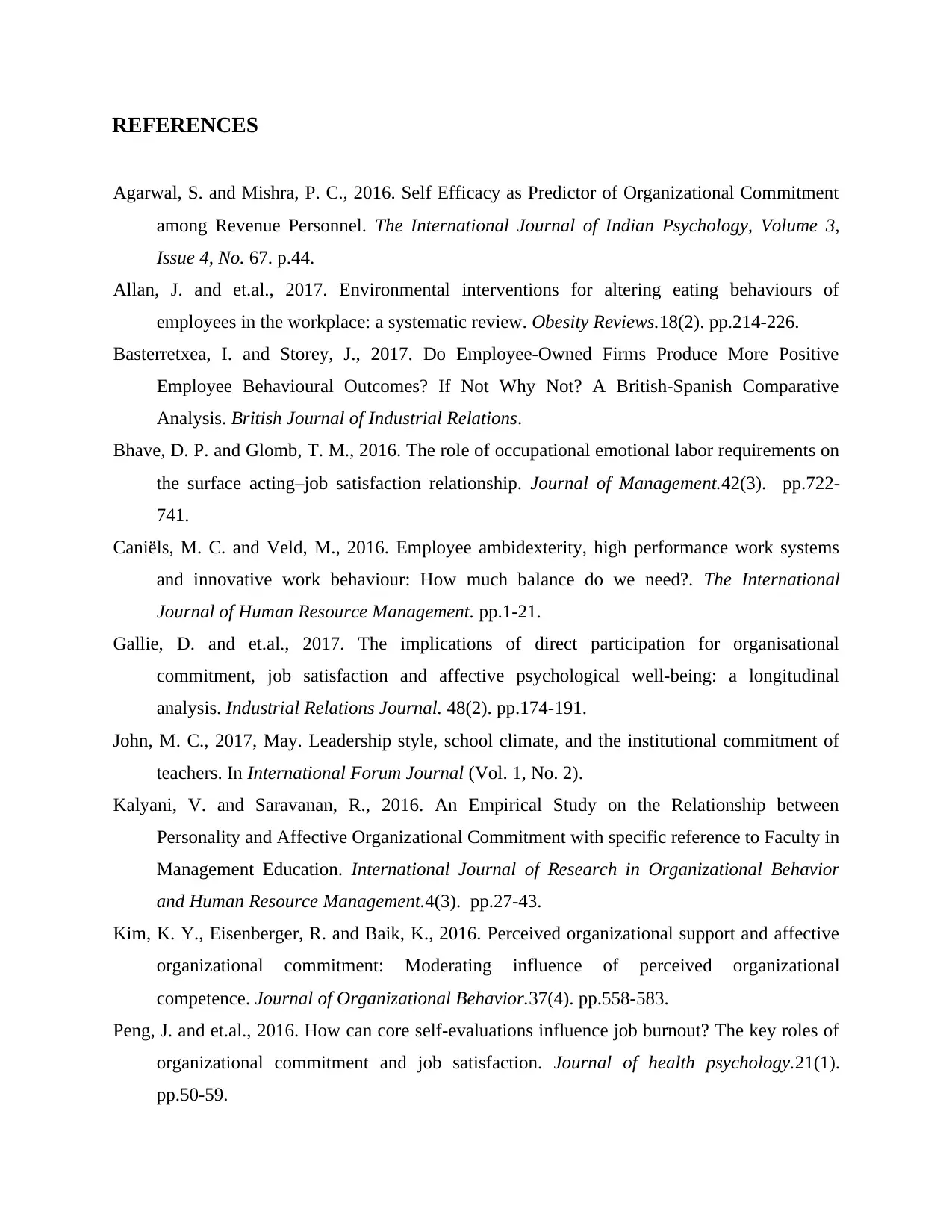
REFERENCES
Agarwal, S. and Mishra, P. C., 2016. Self Efficacy as Predictor of Organizational Commitment
among Revenue Personnel. The International Journal of Indian Psychology, Volume 3,
Issue 4, No. 67. p.44.
Allan, J. and et.al., 2017. Environmental interventions for altering eating behaviours of
employees in the workplace: a systematic review. Obesity Reviews.18(2). pp.214-226.
Basterretxea, I. and Storey, J., 2017. Do Employee‐Owned Firms Produce More Positive
Employee Behavioural Outcomes? If Not Why Not? A British‐Spanish Comparative
Analysis. British Journal of Industrial Relations.
Bhave, D. P. and Glomb, T. M., 2016. The role of occupational emotional labor requirements on
the surface acting–job satisfaction relationship. Journal of Management.42(3). pp.722-
741.
Caniëls, M. C. and Veld, M., 2016. Employee ambidexterity, high performance work systems
and innovative work behaviour: How much balance do we need?. The International
Journal of Human Resource Management. pp.1-21.
Gallie, D. and et.al., 2017. The implications of direct participation for organisational
commitment, job satisfaction and affective psychological well‐being: a longitudinal
analysis. Industrial Relations Journal. 48(2). pp.174-191.
John, M. C., 2017, May. Leadership style, school climate, and the institutional commitment of
teachers. In International Forum Journal (Vol. 1, No. 2).
Kalyani, V. and Saravanan, R., 2016. An Empirical Study on the Relationship between
Personality and Affective Organizational Commitment with specific reference to Faculty in
Management Education. International Journal of Research in Organizational Behavior
and Human Resource Management.4(3). pp.27-43.
Kim, K. Y., Eisenberger, R. and Baik, K., 2016. Perceived organizational support and affective
organizational commitment: Moderating influence of perceived organizational
competence. Journal of Organizational Behavior.37(4). pp.558-583.
Peng, J. and et.al., 2016. How can core self-evaluations influence job burnout? The key roles of
organizational commitment and job satisfaction. Journal of health psychology.21(1).
pp.50-59.
Agarwal, S. and Mishra, P. C., 2016. Self Efficacy as Predictor of Organizational Commitment
among Revenue Personnel. The International Journal of Indian Psychology, Volume 3,
Issue 4, No. 67. p.44.
Allan, J. and et.al., 2017. Environmental interventions for altering eating behaviours of
employees in the workplace: a systematic review. Obesity Reviews.18(2). pp.214-226.
Basterretxea, I. and Storey, J., 2017. Do Employee‐Owned Firms Produce More Positive
Employee Behavioural Outcomes? If Not Why Not? A British‐Spanish Comparative
Analysis. British Journal of Industrial Relations.
Bhave, D. P. and Glomb, T. M., 2016. The role of occupational emotional labor requirements on
the surface acting–job satisfaction relationship. Journal of Management.42(3). pp.722-
741.
Caniëls, M. C. and Veld, M., 2016. Employee ambidexterity, high performance work systems
and innovative work behaviour: How much balance do we need?. The International
Journal of Human Resource Management. pp.1-21.
Gallie, D. and et.al., 2017. The implications of direct participation for organisational
commitment, job satisfaction and affective psychological well‐being: a longitudinal
analysis. Industrial Relations Journal. 48(2). pp.174-191.
John, M. C., 2017, May. Leadership style, school climate, and the institutional commitment of
teachers. In International Forum Journal (Vol. 1, No. 2).
Kalyani, V. and Saravanan, R., 2016. An Empirical Study on the Relationship between
Personality and Affective Organizational Commitment with specific reference to Faculty in
Management Education. International Journal of Research in Organizational Behavior
and Human Resource Management.4(3). pp.27-43.
Kim, K. Y., Eisenberger, R. and Baik, K., 2016. Perceived organizational support and affective
organizational commitment: Moderating influence of perceived organizational
competence. Journal of Organizational Behavior.37(4). pp.558-583.
Peng, J. and et.al., 2016. How can core self-evaluations influence job burnout? The key roles of
organizational commitment and job satisfaction. Journal of health psychology.21(1).
pp.50-59.
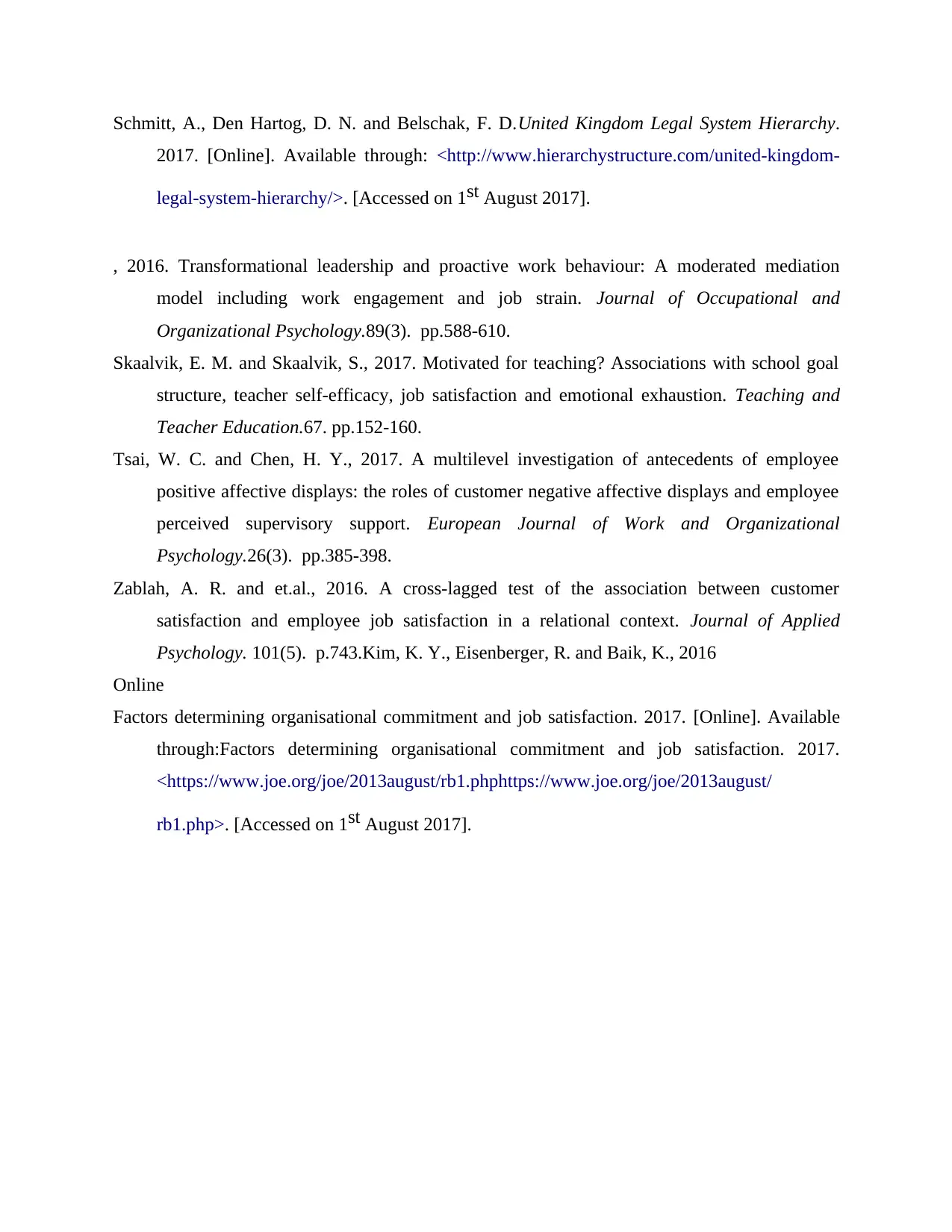
Schmitt, A., Den Hartog, D. N. and Belschak, F. D.United Kingdom Legal System Hierarchy.
2017. [Online]. Available through: <http://www.hierarchystructure.com/united-kingdom-
legal-system-hierarchy/>. [Accessed on 1st August 2017].
, 2016. Transformational leadership and proactive work behaviour: A moderated mediation
model including work engagement and job strain. Journal of Occupational and
Organizational Psychology.89(3). pp.588-610.
Skaalvik, E. M. and Skaalvik, S., 2017. Motivated for teaching? Associations with school goal
structure, teacher self-efficacy, job satisfaction and emotional exhaustion. Teaching and
Teacher Education.67. pp.152-160.
Tsai, W. C. and Chen, H. Y., 2017. A multilevel investigation of antecedents of employee
positive affective displays: the roles of customer negative affective displays and employee
perceived supervisory support. European Journal of Work and Organizational
Psychology.26(3). pp.385-398.
Zablah, A. R. and et.al., 2016. A cross-lagged test of the association between customer
satisfaction and employee job satisfaction in a relational context. Journal of Applied
Psychology. 101(5). p.743.Kim, K. Y., Eisenberger, R. and Baik, K., 2016
Online
Factors determining organisational commitment and job satisfaction. 2017. [Online]. Available
through:Factors determining organisational commitment and job satisfaction. 2017.
<https://www.joe.org/joe/2013august/rb1.phphttps://www.joe.org/joe/2013august/
rb1.php>. [Accessed on 1st August 2017].
2017. [Online]. Available through: <http://www.hierarchystructure.com/united-kingdom-
legal-system-hierarchy/>. [Accessed on 1st August 2017].
, 2016. Transformational leadership and proactive work behaviour: A moderated mediation
model including work engagement and job strain. Journal of Occupational and
Organizational Psychology.89(3). pp.588-610.
Skaalvik, E. M. and Skaalvik, S., 2017. Motivated for teaching? Associations with school goal
structure, teacher self-efficacy, job satisfaction and emotional exhaustion. Teaching and
Teacher Education.67. pp.152-160.
Tsai, W. C. and Chen, H. Y., 2017. A multilevel investigation of antecedents of employee
positive affective displays: the roles of customer negative affective displays and employee
perceived supervisory support. European Journal of Work and Organizational
Psychology.26(3). pp.385-398.
Zablah, A. R. and et.al., 2016. A cross-lagged test of the association between customer
satisfaction and employee job satisfaction in a relational context. Journal of Applied
Psychology. 101(5). p.743.Kim, K. Y., Eisenberger, R. and Baik, K., 2016
Online
Factors determining organisational commitment and job satisfaction. 2017. [Online]. Available
through:Factors determining organisational commitment and job satisfaction. 2017.
<https://www.joe.org/joe/2013august/rb1.phphttps://www.joe.org/joe/2013august/
rb1.php>. [Accessed on 1st August 2017].
⊘ This is a preview!⊘
Do you want full access?
Subscribe today to unlock all pages.

Trusted by 1+ million students worldwide

1 out of 10
Related Documents
Your All-in-One AI-Powered Toolkit for Academic Success.
+13062052269
info@desklib.com
Available 24*7 on WhatsApp / Email
![[object Object]](/_next/static/media/star-bottom.7253800d.svg)
Unlock your academic potential
Copyright © 2020–2025 A2Z Services. All Rights Reserved. Developed and managed by ZUCOL.





